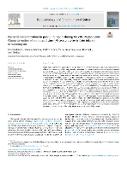| dc.contributor.author | Smělíková, Eva | |
| dc.contributor.author | Krůtová, Marcela | |
| dc.contributor.author | Čapek, Václav | |
| dc.contributor.author | Brajerová, Marie | |
| dc.contributor.author | Dřevínek, Pavel | |
| dc.contributor.author | Tkadlec, Jan | |
| dc.date.accessioned | 2025-01-08T10:40:55Z | |
| dc.date.available | 2025-01-08T10:40:55Z | |
| dc.date.issued | 2025 | |
| dc.identifier.uri | https://hdl.handle.net/20.500.14178/2790 | |
| dc.description.abstract | Public transport represents a potential site for the transmission of resistant pathogens due to the rapid movement of large numbers of people. This study aimed to investigate the bacterial contamination of frequently touched surfaces in the public transport system operating in the proximity of the biggest Czech hospital during the coronavirus pandemic despite extensive cleaning and disinfection efforts. In June and September 2020, samples from the metro trains, ground transport and stationary objects were collected, enriched and cultured. The antimicrobial susceptibility was tested by broth microdilution. Staphylococcus aureus isolates exhibiting inconclusive results of vancomycin susceptibility testing were retested by broth macrodilution and subjected to whole genome sequencing. All S. aureus isolates were tested for vancomycin heteroresistance (hVISA). A total of 513/542 (94.6 %) samples were culture-positive with higher frequency in September (p = 0.004). S. aureus was the most frequent opportunistic bacterial pathogen found (3.7 %, 20/542) followed by Enterobacterales spp. (1.8 %, 10/542). No methicillin-resistant S. aureus (MRSA), extended-spectrum beta-lactamase producers (ESBL) or carbapenemase-producing bacteria were detected. Resistance to clinically relevant drugs was rare except for resistance to ampicillin (67 %, 8/12), cefuroxime (42 %, 5/12) in Enterobacterales and chloramphenicol (90 %, 18/20), penicillin (45 %, 9/20), and erythromycin (20 %, 4/20) in S. aureus. One S. aureus isolate was shown to be resistant to vancomycin (8 mg/L) by forming large visible cell aggregates. Population analysis profile-area under the curve ratio (PAP-AUC) testing did not confirm the hVISA phenotype, but mutations in the hVISA phenotype-related gene vraR and other genes related to cell wall synthesis (fmtB) and intercellular adhesion (sasC) were found. Our study shows that in the COVID-19 pandemic, despite the intensive use of disinfectants, public transport was a source of opportunistic bacterial pathogens including S. aureus with unusual vancomycin resistance phenotype that could be easily missed by standard susceptibility testing. | en |
| dc.language.iso | en | |
| dc.relation.url | https://doi.org/10.1016/j.ecoenv.2024.117624 | |
| dc.rights | Creative Commons Uveďte původ 4.0 International | cs |
| dc.rights | Creative Commons Attribution 4.0 International | en |
| dc.title | Bacterial contamination in public transport during COVID-19 pandemic: Characterization of an unusual Staphylococcus aureus isolate tolerant to vancomycin | en |
| dcterms.accessRights | openAccess | |
| dcterms.license | https://creativecommons.org/licenses/by/4.0/legalcode | |
| dc.date.updated | 2025-02-06T15:40:58Z | |
| dc.subject.keyword | Antimicrobial resistance | en |
| dc.subject.keyword | Environmental contamination | en |
| dc.subject.keyword | Public transport | en |
| dc.subject.keyword | Staphylococcus aureus | en |
| dc.subject.keyword | Vancomycin resistance | en |
| dc.subject.keyword | Whole genome sequencing | en |
| dc.identifier.eissn | 1090-2414 | |
| dc.relation.fundingReference | info:eu-repo/grantAgreement/MSM//LX22NPO5103 | |
| dc.relation.fundingReference | info:eu-repo/grantAgreement/FN/I-FN/I-FNM | |
| dc.date.embargoStartDate | 2025-02-06 | |
| dc.type.obd | 73 | |
| dc.type.version | info:eu-repo/semantics/publishedVersion | |
| dc.identifier.doi | 10.1016/j.ecoenv.2024.117624 | |
| dc.identifier.utWos | 001407905800001 | |
| dc.identifier.eidScopus | 2-s2.0-85213884509 | |
| dc.identifier.obd | 657167 | |
| dc.identifier.pubmed | 39752915 | |
| dc.subject.rivPrimary | 30000::30300::30303 | |
| dcterms.isPartOf.name | Ecotoxicology and Environmental Safety | |
| dcterms.isPartOf.issn | 0147-6513 | |
| dcterms.isPartOf.journalYear | 2025 | |
| dcterms.isPartOf.journalVolume | 289 | |
| dcterms.isPartOf.journalIssue | January | |
| uk.faculty.primaryId | 109 | |
| uk.faculty.primaryName | 2. lékařská fakulta | cs |
| uk.faculty.primaryName | Second Faculty of Medicine | en |
| uk.faculty.secondaryId | 52 | |
| uk.faculty.secondaryName | Fakultní nemocnice v Motole | cs |
| uk.faculty.secondaryName | Motol University Hospital | en |
| uk.department.primaryId | 109 | |
| uk.department.primaryName | 2. lékařská fakulta | cs |
| uk.department.primaryName | Second Faculty of Medicine | en |
| uk.department.secondaryId | 1701 | |
| uk.department.secondaryId | 100010693902 | |
| uk.department.secondaryName | Ústav lékařské mikrobiologie | cs |
| uk.department.secondaryName | Ústav lékařské mikrobiologie | en |
| uk.department.secondaryName | Ústav lékařské mikrobiologie 2. LF UK a FN Motol | cs |
| uk.department.secondaryName | Department of Medical Microbiology, 2nd Faculty of Medicine and Motol University Hospital | en |
| dc.type.obdHierarchyCs | ČLÁNEK V ČASOPISU::článek v časopisu::původní článek | cs |
| dc.type.obdHierarchyEn | JOURNAL ARTICLE::journal article::original article | en |
| dc.type.obdHierarchyCode | 73::152::206 | en |
| uk.displayTitle | Bacterial contamination in public transport during COVID-19 pandemic: Characterization of an unusual Staphylococcus aureus isolate tolerant to vancomycin | en |

